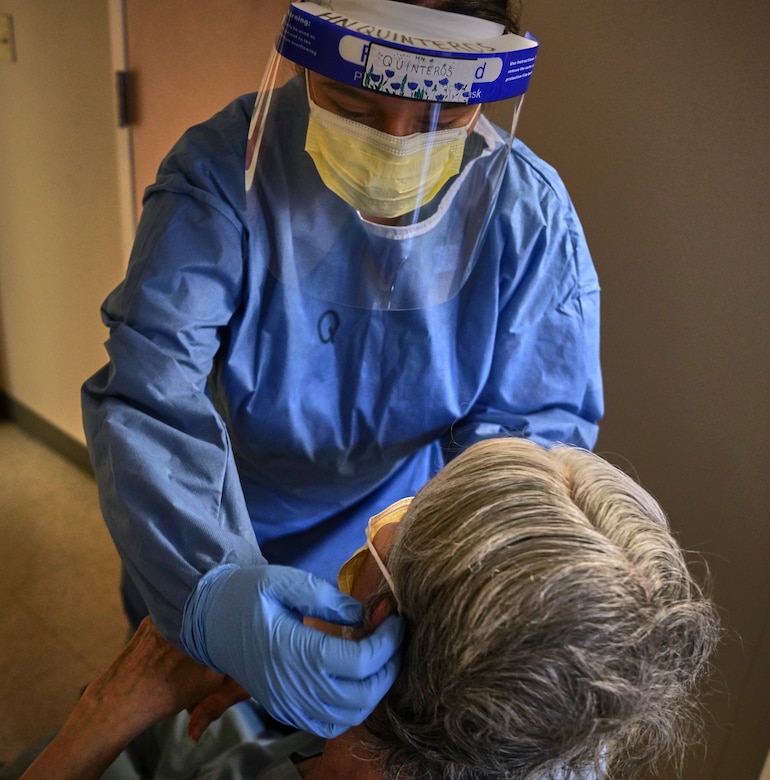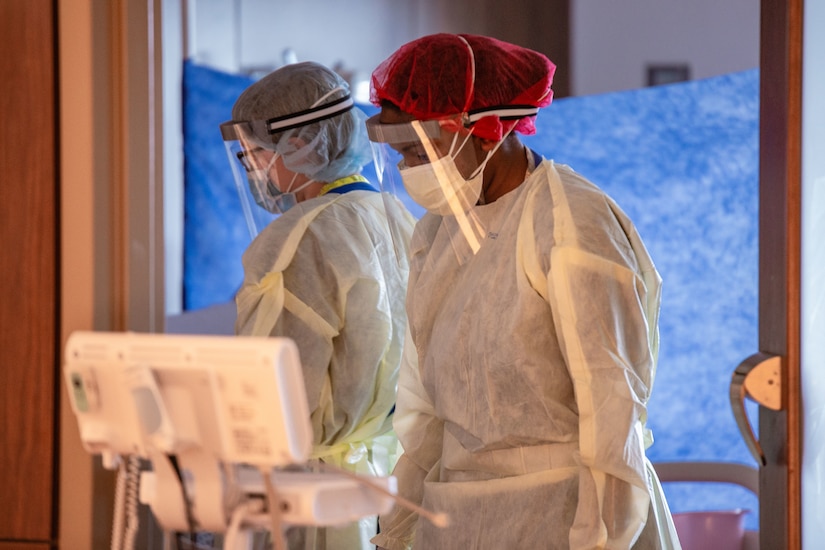Since the beginning of the pandemic, Navy Medicine has continually adapted to meet the evolving nature of COVID-19. One example is the historic deployment of Naval Hospital Jacksonville's Expeditionary Medical Facility-M.
On March 30, EMF-M answered the nation’s call by doing what no other expeditionary hospital has ever done: it deployed to five stateside locations simultaneously in support of a pandemic response.
EMFs — known as Fleet Hospitals prior to 2005 — are forward deployed platforms with Role Three medical and surgical capabilities designed to increase the survivability of those injured in a combat theater. They are the Navy's equivalent to Mobile Army Surgical Hospital, or MASH, units made popular by the film and TV series of the same name. For the Navy, they have been deployed in one form or another since World War II, but historically, nothing quite compares to the pandemic mission.

Navy Capt. Kevin Brown, who served as EMF-M's commanding officer for this deployment, acknowledged the uniqueness of the mission.
''The traditional deployment of an EMF would be into a theater where there's some sort of activity, usually it's a combat related activity, on the ground that would be generating [or would be anticipated to generate] a large number of combat related casualties,'' Brown said.
Brown said he began hearing rumors in mid-March that the EMF-M would mobilize as part of the U.S. Northern Command pandemic response as part of the Federal Emergency Management Agency's request for Defense Support to Civil Authorities. The destination was uncertain, and there was discussion about possible deployments to Montana, Wyoming or the Jacob K. Javits Convention Center in New York. But within 48 hours of a planned deployment to New York, the destination changed, with the EMF now being sent to Dallas and New Orleans to serve as ''release valves'' for the local hospital systems.
Brown sent planning cells to these cities to determine their requirements and to work with local community leaders on how the Navy could best support the mission. Unlike typical EMF wartime missions, the Navy did not use pre-positioned equipment for setting up a 150-bed hospital. Instead this mission called for the EMF to supply the personnel based on the requirements of local communities as validated by FEMA. For this mission, EMF-M tapped into its pool of 450 medical providers attached to the platform and distributed them to each location by requirement. As additional needs materialized at other locations, personnel were taken from the original two detachments, as well as those serving on standby awaiting orders.
Two weeks into the original mission, EMF-M transferred 104 medical providers from the Dallas and New Orleans detachments to Baton Rouge, Louisiana, where they staffed two 30-bed COVID-19 wards and helped care for some 600 patients.
As the Baton Rouge mission was getting underway, EMF-M was deploying another detachment to the hospital ship USNS Comfort in New York.
''It was decided they needed more critical care capability, and where was the Navy going to find it?'' Brown said. ''Well, the Navy's going to find it in its 'Tier One' assets.''
Navy Cmdr. Meredith Miller served as the officer in charge for the EMF's USNS Comfort detachment. She and her team of 50 critical care specialists received orders for deployment April 13, and were aboard the ship the next day. The presence of the detachment gave the beleaguered medical staff much-needed support.
''When you realized some of them had worked 14 days straight, 12-on-12-off, ... they were just ecstatic to have more support,'' Miller said. ''So, we were pretty excited to be there and be able to jump in and help the team.''
On April 24, the fifth and final detachment deployed to the Bennett Medical Center in Stamford, Connecticut. Forty-nine members of the EMF-M worked in conjunction with 85 Army Reserve soldiers with the 811-1 Urban Augmentation Medical Task Force to provide support in treating COVID-19 patients.

For Navy Capt. Chad Roe, the executive officer of the EMF and the Dallas detachment's officer in charge, this was another example of how Navy Medicine comes together to accomplish a specialized mission.
''If it's Afghanistan, or if it's shipboard in the middle of the Baltic Sea, you've got a group of people who know how to take care of patients and to get a mission done,'' Roe said. ''And it's been a real pleasure to be able to come in and support that in your own country.''
Brown said he believes that the unprecedented nature of the deployment enabled a great deal of latitude for how to meet the mission requirements.
''The bad news was that there was no templated plan for how to break an EMF into five detachments and organize it in a way where you can maintain positive command and control'' Brown said. ''The good news is there was no template that locked us in.''
As for the hallmarks of the mission, both Brown and Roe note the resilience and adaptability of EMF-M personnel.
''We were going into a situation that was completely uncertain; and once we had an understanding of what the local community needed, we would have to somehow figure it out and get it done,'' Brown said. ''And the folks on the deployments were willing to participate in that chaos and do it with a smile and do it with a high level of professionalism and integrity.''
EMF-M's last operating detachment wrapped up its mission in Baton Rouge on May 31. Over two months, some 340 members of EMF-M deployed in support of the pandemic response.
(André Sobocinski is assigned to the U.S. Navy Bureau of Medicine and Surgery.)
No comments:
Post a Comment